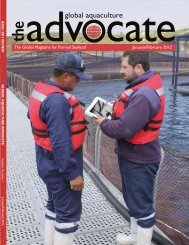May/June 2010 - Global Aquaculture Alliance
May/June 2010 - Global Aquaculture Alliance
May/June 2010 - Global Aquaculture Alliance
You also want an ePaper? Increase the reach of your titles
YUMPU automatically turns print PDFs into web optimized ePapers that Google loves.
marketplace<br />
Shrimp Problems In Indonesia? Imports From Ecuador<br />
Continue Strong As White Conversion Continues<br />
U.S. imports of cooked shrimp were off in January,<br />
while breaded imports rose.<br />
Summary:<br />
January saw a shortage of large shrimp, especially black<br />
tigers. Continuing production problems in Indonesia<br />
may affect future U.S. shrimp imports from this main<br />
supplier. More white shrimp production will be an<br />
interesting dynamic in <strong>2010</strong>. Fresh and frozen whole<br />
salmon imports continued to see YTD increases in January,<br />
while fillets began <strong>2010</strong> lower. Norway was the top<br />
source for fresh fillets. In January, total tilapia imports<br />
to the U.S. increased over December 2009. Fresh fillets<br />
registered a more than modest increase, while frozen fillets<br />
recorded a monthly record high.<br />
In January, imports of shrimp to the United States began the<br />
year down a slight 1.8% from levels a year ago (Table 1). However,<br />
there were some noticeable trends in imports that may<br />
indicate future supplies.<br />
Production<br />
Most importantly, import volume from Indonesia was down<br />
sharply the last two months in a row. When added to anecdotal<br />
Form<br />
Shell-on<br />
Peeled<br />
Cooked<br />
Breaded<br />
Total<br />
January <strong>2010</strong><br />
(1,000 lb)<br />
34,008<br />
29,673<br />
18,289<br />
9,209<br />
92,755<br />
Sources: U.S. Census, Urner Barry Publications, Inc.<br />
information, this fact appeared to indicate continuing production<br />
problems that may affect supplies going forward for the number<br />
2 supplier to the U.S. market. In addition, Bangladesh imports<br />
continued their downward trend from 2009 with reports that<br />
much of their production was destined for Russia.<br />
Imports from Thailand were only slightly lower in January,<br />
and for the last several years have been very steady. After an<br />
increase in 2009, Ecuador’s shrimp exports to the U.S. continue<br />
strong. Imports from China for the first month of the year were<br />
also higher with an increase in breaded imports. Vietnam product<br />
– lower in 2009 – also begin the year slightly lower. Imports<br />
from Malaysia, after an off year in 2009, were sharply higher for<br />
January, while those from Mexico were lower.<br />
Total headless, shell-on imports were up slightly in January,<br />
with white imports up and black tiger imports lower. Peeled<br />
shrimp and cooked shrimp imports were lower. Led by China,<br />
breaded imports were higher.<br />
Shrimp Market<br />
The most glaring market condition in January was that large<br />
shrimp in all categories were short, especially large black tiger<br />
shrimp. This situation may be exacerbated by an improving<br />
demand until new season production is available in late spring.<br />
Large white shrimp, which had lagged behind the black tiger<br />
market, also saw improving buying interest for 21-25 count and<br />
larger shrimp. The market was generally firm.<br />
Medium and smaller white shrimp have recently been mostly<br />
steady. The market has now begun to seasonally strengthen. The<br />
market tone, although recently firm, remains somewhat unsettled<br />
as sellers evaluate demand in relation to the supply.<br />
A continuing trend that will be an interesting dynamic this<br />
year is the addition of white shrimp production in India and a<br />
further move to white production in many other producing<br />
countries.<br />
Table 1. Snapshot of U.S. shrimp imports, January <strong>2010</strong>.<br />
December 2009<br />
(1,000 lb)<br />
40,489<br />
36,044<br />
21,853<br />
8,110<br />
108,186<br />
Change<br />
(Month)<br />
-16.0%<br />
-17.7%<br />
-16.3%<br />
13.6%<br />
-14.3%<br />
Paul Brown, Jr.<br />
pbrownjr@urnerbarry.com<br />
Janice Brown<br />
Angel Rubio<br />
Urner Barry Publications, Inc.<br />
P. O. Box 389<br />
Toms River, New Jersey 08754 USA<br />
January 2009<br />
(1,000 lb)<br />
32,320<br />
32,070<br />
20,804<br />
7,226<br />
94,491<br />
Change<br />
(Year)<br />
5.2%<br />
-7.5%<br />
-12.1%<br />
27.4%<br />
-1.8%<br />
YTD <strong>2010</strong><br />
(1,000 lb)<br />
34,008<br />
29,673<br />
18,289<br />
9,209<br />
92,755<br />
YTD 2009<br />
(1,000 lb)<br />
32,320<br />
32,070<br />
20,804<br />
7,226<br />
94,491<br />
Change<br />
(Year)<br />
5.2%<br />
-7.5%<br />
-12.1%<br />
27.4%<br />
-1.8%<br />
global aquaculture advocate <strong>May</strong>/<strong>June</strong> <strong>2010</strong> 69





